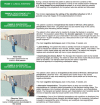Virtual reality in the treatment of eating disorders
- PMID: 34048622
- PMCID: PMC8362149
- DOI: 10.1002/cpp.2622
Virtual reality in the treatment of eating disorders
Abstract
Over the last 25 years, virtual reality (VR) has offered innovative solutions for targeting different key symptoms of eating disorders: from craving to negative emotions, from attentional biases to body dissatisfaction. The present narrative review assesses the existing literature in these areas trying to identify their different levels of clinical evidence. Specifically, the review presents four clinical approaches based upon VR and their implications in the treatment of eating disorders: VR cue exposure, VR reference frame shifting, VR for correcting body distortions and attentional biases. In general, existing findings demonstrate the clinical value of VR. On one side, the present review suggests that two VR-based techniques-VR exposure and reference frame shifting-have a significant research support and provide a possible advantage over traditional cognitive-behavioural therapy (CBT) for bulimia nervosa and binge eating disorder. On the other side, two emerging VR applications-multisensory body illusions and the use of VR for the modification of attentional biases-even if supported by preliminary data still need further research.
Keywords: VR cue exposure; VR reference frame shifting; attentional biases; eating disorders; full body illusions; virtual reality.
© 2021 The Authors. Clinical Psychology & Psychotherapy published by John Wiley & Sons Ltd.
Conflict of interest statement
The authors declare no conflict of interest.
Figures
Similar articles
-
[Use of virtual reality in eating disorders].Encephale. 2021 Jun;47(3):263-269. doi: 10.1016/j.encep.2020.11.003. Epub 2021 Apr 2. Encephale. 2021. PMID: 33814164 French.
-
A Randomized Trial of Virtual Reality-Based Cue Exposure Second-Level Therapy and Cognitive Behavior Second-Level Therapy for Bulimia Nervosa and Binge-Eating Disorder: Outcome at Six-Month Followup.Cyberpsychol Behav Soc Netw. 2019 Jan;22(1):60-68. doi: 10.1089/cyber.2017.0675. Epub 2018 Jul 30. Cyberpsychol Behav Soc Netw. 2019. PMID: 30059240 Clinical Trial.
-
A Randomised Controlled Comparison of Second-Level Treatment Approaches for Treatment-Resistant Adults with Bulimia Nervosa and Binge Eating Disorder: Assessing the Benefits of Virtual Reality Cue Exposure Therapy.Eur Eat Disord Rev. 2017 Nov;25(6):479-490. doi: 10.1002/erv.2538. Epub 2017 Aug 14. Eur Eat Disord Rev. 2017. PMID: 28804985 Clinical Trial.
-
Virtual Reality-Based Immersive Rehabilitation for Cognitive- and Behavioral-Impairment-Related Eating Disorders: A VREHAB Framework Scoping Review.Int J Environ Res Public Health. 2022 May 10;19(10):5821. doi: 10.3390/ijerph19105821. Int J Environ Res Public Health. 2022. PMID: 35627357 Free PMC article.
-
Harnessing Immersive Virtual Reality: A Comprehensive Scoping Review of its Applications in Assessing, Understanding, and Treating Eating Disorders.Curr Psychiatry Rep. 2024 Sep;26(9):470-486. doi: 10.1007/s11920-024-01523-2. Epub 2024 Jul 31. Curr Psychiatry Rep. 2024. PMID: 39083129 Free PMC article.
Cited by
-
Development, usability, and preliminary efficacy of a virtual reality experience to promote healthy lifestyle behaviors in children: pilot randomized controlled trial.Mhealth. 2024 Oct 21;10:29. doi: 10.21037/mhealth-24-24. eCollection 2024. Mhealth. 2024. PMID: 39534453 Free PMC article.
-
A Narrative Review on the Neurocognitive Profiles in Eating Disorders and Higher Weight Individuals: Insights for Targeted Interventions.Nutrients. 2024 Dec 23;16(24):4418. doi: 10.3390/nu16244418. Nutrients. 2024. PMID: 39771039 Free PMC article. Review.
-
Younger and Older Adults' Cognitive and Physical Functioning in a Virtual Reality Age Manipulation.Front Aging. 2022 Apr 27;3:851687. doi: 10.3389/fragi.2022.851687. eCollection 2022. Front Aging. 2022. PMID: 35821808 Free PMC article.
-
An Attentional Bias Modification Task, through Virtual Reality and Eye-Tracking Technologies, to Enhance the Treatment of Anorexia Nervosa.J Clin Med. 2023 Mar 11;12(6):2185. doi: 10.3390/jcm12062185. J Clin Med. 2023. PMID: 36983186 Free PMC article.
-
Using VR Supermarket for Nutritional Research and Education: A Scoping Review.Nutrients. 2025 Mar 12;17(6):999. doi: 10.3390/nu17060999. Nutrients. 2025. PMID: 40290013 Free PMC article.
References
-
- APA . (2013). Diagnostic and statistical manual of mental disorders (5th ed.). Washington, DC: American Psychiatric Association.
Publication types
MeSH terms
Grants and funding
LinkOut - more resources
Full Text Sources
Other Literature Sources
Medical


